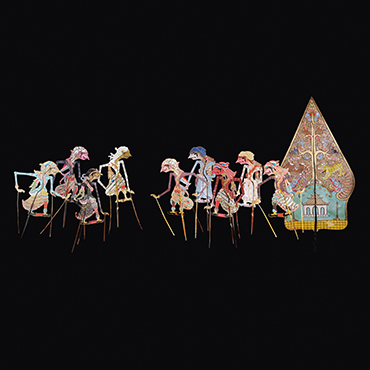The Sonobudoyo Museum derives its name from the Javanese words sono (place) and budoyo (culture) meaning “place of culture.” Founded in AH 1353/1935 CE by the Java Institute during the Dutch colonial period, the museum is located in Yogyakarta, Indonesia. It houses a collection of around 63,000 works of art and material culture objects from Java, Madura, Bali and Lombok. Among the highlights of the collections are masterpieces testifying to the rich cultural heritage of the Islamic courts of Java, as well as earlier Hindu-Buddhist art. In recent years the museum has undergone an exciting revitalisation through developing new exhibition spaces and public visitor programs, receiving the AH 1441/2020 CE national Purwakalagrha Indonesia Museum Award in recognition of its achievements.
In Javanese shadow puppet theater, there is a unique performance tradition that tells the stories and teachings of the nine Muslim figures, wali songo, who played a key role in the introduction and spread of Islam in Java during the 9th to 10th centuries AH/15th to 16th centuries CE. The number nine holds a special place in local folklore, rooted in symbolism from the pre-Islamic era. It represents the four cardinal and the four intercardinal directions of the island, along with the center. This concept is reflected in the display, where eight batik fabric pieces (symbolizing infinity) surround the dolls, forming a harmonious composition of nine interconnected elements.
Set of wali songo puppets
Wayang sadat is a form of wayang kulit (shadow puppet theater) that was developed specifically to convey Islamic principles and preserve Islamic traditions in Indonesia. It was invented in AH 1405/1985 CE by Suryadi Warnasukarja, the maker of the puppets shown in AlMadar, in Trucuk, Klaten, Indonesia. The performances feature the nine Muslim figures who brought Islam to the island of Java. The first is Sunan Gresik, also known as Sheikh Maulana Malik Ibrahim, who migrated from Türkiye to Java in AH 806/1404 CE and is considered the father of the Wali Songo. His son Sunan Ampel played an important role in conversions in the Majapahit kingdom. Other figures include Sunan Gunungjati, active in Cirebon, West Java, and Sunan Giri, a founder of the first Islamic kingdom in Java. Also on view is a motif, Gunungan, which includes a five-rooted tree, (symbolizing the pillars of Islam), a tajug-shaped mosque with three doors (representing faith, Islam and ihsan), and pillars on either side (denoting the Qur’an and hadith).
Wayang sadat performances are typically accompanied by a gamelan orchestra consisting of gongs, drum, and xylophones. Although the puppets are decorated in detail and in vivid color, the audience sits in front of a translucent screen where they can only see their monochrome shadows.
from right to left: Gunungan, Sunan Kudus, Sunan Gresik, Sunan Drajat, Sunan Ampel, Sunan Gunungjati, Sunan Giri, Sunan Kalijaga, Sunan Bonang and Sunan Tembayat
By Suryadi Warnasukarja
Klaten, Central Java, Indonesia, AH 1405/1985 CE
Leather parchment with pigment, buffalo-horn, each approx. h. 42 × w. 16 cm
The collection of Sonobudoyo Museum, Yogyakarta Indonesia, 03.10.6.462, 03.10.6.466, 03.10.6.9526, 03.10.6.9511, 03.10.6.467, 03.10.6.473, 03.10.6.9521, 03.10.6.463, 03.10.6.472, 03.10.6.471

